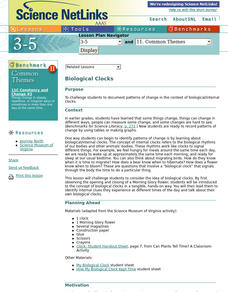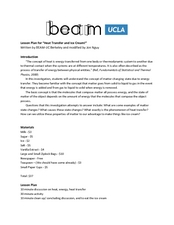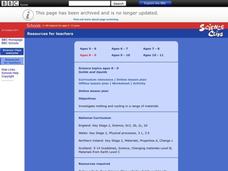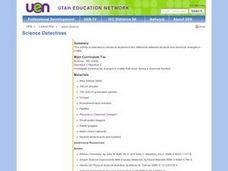Curated OER
Up and Atom
"Up and Atom" is a mini-unit introducing middle-schoolers to the wonders of elements. Participants draw atom models, examine the periodic table, compare samples of metals to nonmetals, identify unknown elements, and more! The beginning...
Curated OER
Exploring a New World
Fifth graders create a PowerPoint presentation about Christopher Columbus. The integration of technology helps them to be engaged in the subject matter. The basis for the information in the presentation is for students to answer some...
Curated OER
Water 1: Water and Ice
Students discover the forms water can take. In this hands-on science lesson, students examine how water can change from a solid to a liquid and then back again.
Curated OER
Ice Cream Blizzards
Fourth graders explore whether the making of homemade ice cream is a physical change or a chemical change in a lab experiment. Students identify states of matter, describe the physical properties of states, and collect temperature data...
Curated OER
Force and Motion - Part 2
Students test different objects such as dominoes, marshmallows, slides, and more to test their force, motion, gravity, friction, and the concept of matter. For this force and motion lesson plan, students understand that the force an...
Curated OER
Water 1: Water and Ice
Students investigate water in its solid and liquid form. In this states of matter lesson, students experiment to see what happens as water goes from a solid, ice, to a liquid, water, and back again. They write about and illustrate the...
Curated OER
Solids, Liquids, and Gases
First graders explore the properties of matter. In this states of matter activity, 1st graders conduct scientific investigations that require them to mix, cool, and heat objects in order to observe changes in the properties of matter.
Curated OER
"Heat Transfer and Ice Cream!"
Students analyze earth science by creating a frozen treat in class. In this heat transfer lesson, students discuss how matter is transformed from solid to liquid and liquid to gas when energy is removed from the equation. Students...
Curated OER
Melt the Ice
Students examine and discuss how water changes from a liquid to a solid to a gas. They explore this concept by having an ice cube race, competing to see which group can change the solid water back into liquid water first.
Curated OER
Solids, Liquids, and Gases
Learners explore solids, liquids, and gasses and categorize and describe the three states of matter. In this chemistry lesson, students categorize items as solid, liquid, or gas based on the definitions given by the teacher. Learners...
Curated OER
Hot Stuff
Students investigate if heat can change the form of matter. In this physics lesson, students use heat sources to observe the changes in an ice cube. Students graph which heat source changed the matter the fastest.
Curated OER
Solids and Liquids
Learners investigate what happens to solids and liquids when they change from one form to another. In this states of matter lesson, students work in groups on a virtual experiment that requires them to collect data regarding the melting...
Curated OER
Gases Around Us
Students investigate gases and liquids. In this states of matter online lesson, students examine how evaporation plays a part in the transition of liquids into gases as they watch a kettle of water boil and then work in small groups on...
Curated OER
Water and Ice
Young scholars experiment with water and ice. For this states of matter lesson, students explore how water can change from a solid to a liquid and back again. They discuss and write about the results of the experiment in a science...
Curated OER
Science Detectives
Fifth graders examine the differences between chemical and physical changes. As a class, they are read a scenerio and determine whether it was deliberate act or not. In groups, they observe the changes of an alka-seltzer tablet and...
Curated OER
Elements In Chemistry: Solids, Liquids and Gases
Students investigate the kinetic-molecular theory. In this state of matter lesson, students consider the differences of melting glaciers, melting icebergs and investigate on what happens when submerged water melts.
Curated OER
One Plus One Makes New
Students discover the properties of matter and how they change when composite materials are produced. In this informative instructional activity students write up a question and procedure to an experiment then analyze and draw...
Curated OER
Water and Ice
Students study the liquid and solid states of water. In this water states lesson, students complete three experiments to study water as it cycles from a liquid state to a solid state and back. Students finish with a Venn Diagram...
Curated OER
Outrageous Ooze
Students examine states of matter. In this solids and liquids lesson, students conduct a scientific investigation that requires them to make ooze and record their observations pertaining to it.
Curated OER
Water and Ice
Students examine water. In this chemistry lesson, student examine the physical properties of water and how it changes from a liquid to a solid or a gas. This lesson contains links to a second and third complimentary lesson on...
Curated OER
The Day the Atom Died (Grade K-1)
Students investigate what is wrong with the Rutherford atomic model. In this chemistry lesson, students answer questions about the atomic model after watching a video. They draw conclusions from the video and discuss how the atomic model...
Curated OER
Model Mania
Eighth graders study the conservation of matter. In this chemical reaction lesson plan students examine what happens during a chemical reaction and complete a lab activity.
Curated OER
Crystals: What Are They and What Holds Them Together
Students are introduced to the characteristics of crystals and what keeps them together. Using the Periodic Table, they examine the various elements and develop a model of an atom. In groups, they place sugar and salt in petri dishes...
Curated OER
The Same But Different
Fourth graders identify the characteristics of a simple physical change. They describe objects by the properties of the materials from which they are made. Students discuss the different states of matter and their distinct physical...























